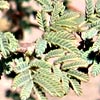Acacia tortilis is a low desert tree with an impressive umbrella shaped canopy: several equal sized branches originate from one point at the soil surface. They grow outward symmetrically in all directions, at an angle of 30 degrees from the perpendicular, and create an inverted cone. The young branches are reddish and covered with felt-like hairs (hirsute). Resin is produced from the bark of the tree.
The tree grows deep roots. It grows in places where there is water at great depths and exploits water stores with which other plants cannot compete. It is common mainly in soils of seasonal streams in the Arava and the Dead Sea Valley. The height of the tree varies according to the amount of water in its rhizosphere, between 1 and 5 meters.
It is prominent in the landscape, and holds a major position in the ecosystem.
Acacia tortilis is very thorny. The stipules form sharp and rigid thorns. Indeed, its young leaves need all possible protection in an environment where every green sprout is in great demand. Nonetheless, the camel succeeds in sticking its lips between the thorns and biting the leaves. Gazelles feed on fallen fruits. Furthermore, its seeds will germinate better after they have passed through the gazelle’s stomach.
The tree belongs to the Mimosaceae family, in the Leguminosae order. The leaves are alternate, pinnate. There is a single nectary on the leaf axis. The leaves are shed in the summer.
Acacia tortilis blooms from April to December, but mainly in autumn. The flowers are yellowish, arranged densely in a small ball, as in the other members of the genus. The filaments of the stamens are long, protrude from the corolla and from the flower-ball. The fruit is a pilose curled legumen. The young leaves and branches are pilose.
Its global distribution extends mainly in the Sudan and East Africa.
The genus Acacia contains 750 species, half of which grow in Australia and the Pacific Ocean islands. In Israel there are 4 species that grow wild and several other domesticated species.
Written by Mike Livne






